The Church and the Jews: Late Antiquity
The Mediterranean world of Late Antiquity (for our purposes, first to sixth centuries C.E.) was a very cosmopolitan one. The European world that was to develop into a major civilization in later centuries was regarded by first-century Romans as barbaric and uncouth. Among the elite, to be accepted as part of the Roman world meant to adopt its life style, its education, and its languages - Latin in the west and Greek in the east. Persons of diverse ethnic and religious backgrounds were absorbed into this culture rather easily. An educated "Roman" of any background was expected to adopt a pagan education of a highly sophisticated kind - based on classical philosophy, not on the worship of idols. Late Antiquity was, for the urban elite, a period of great creativity and luxury. For many, though, it was accompanied by a mood of inner anxiety. The old forms of pagan life did not satisfy an emerging self-consciousness among men and women, an awareness of a complex emotional self. For those who could not attain a classical education - women and the lower classes - a sense of exclusion added to the dissatisfaction. Quite a while before Paul began preaching to the gentiles (a topic we will be looking at more closely), there were pagans in the Roman world who were drawn to a religious system that offered a more intimate relationship with God and community, and a persuasive path to a life of righteousness. This was Judaism - Pharisaic Judaism (see below). Surprising as it may seem, the number of gentiles who converted to Judaism in this period appears to be rather high. What drove people to make this radical change? It was in some ways the same impulse that drove other gentiles in a later generation to convert to Christianity. It is described by the historian Peter Brown this way:By the first century C.E. Jews lived throughout the Roman Empire (and beyond it to the east) in a far-flung diaspora. (Some lived beyond Roman imperial boundaries to the east, but we will limit ourselves to the majority who lived within the Empire.) The Holy Land, known as Judaea by the Romans, had come under Roman rule in 63 BCE. Greco-Roman influence was felt throughout the diaspora. How did Jews feel about the pagan Greco-Roman world around them?The idea of "conversion" was closely related to the idea of "revelation." Between them, the two ideas opened a breach in the high wall of classical culture for the average man. By "conversion" he gained a moral excellence which had previously been reserved for the classical Greek and Roman gentleman because of his careful grooming and punctilious conformity to ancient models. By "revelation" the uneducated might get to the heart of vital issues, without exposing himself to the high costs…and to the heavy traditionalism of […an] education in philosophy. (Peter Brown, The World of Late Antiquity, p. 53)
The first-century Jewish world was quite diverse, and divided on many issues - including this one. In general, the political and economic elite tended to adopt Greco-Roman culture; the rank-and-file of Jewish society tended to resist it. But consciously or not, all Jews who lived in the urban centers of the cosmopolitan world of Late Antiquity were influenced by the ideas and ways of thinking of that world. (Stop for a moment and examine the ruins of the synagogue complex in Sardis, built sometime before the third century C.E. [see inset]: its architecture seems indistinguishable from that of a "pagan" Roman structure.)
Even in their religious thinking, educated Jews were sometimes touched by the world of pagan philosophy. For such Jews, the pagan world offered a vocabulary of concepts that seemed compelling - one that was lacking in traditional Judaism. This did not mean that these Jews ceased to accept basic Jewish theology and practice. But they adapted their Jewish outlook to harmonize, to a greater or lesser degree, with pagan philosophy. The outstanding example of a Jew who sought to harmonize classical concepts and traditional Judaism was the Jewish platonic thinker Philo of Alexandria (ca. 20 B.C.E.-40 C.E.).
In his own way, Saul of Tarsus - who was to become St. Paul - was a Jew who had acculturated to currents in the classical world. His father was a Roman citizen, as were many Jews in this period. He lived in a town whose very contours reflected the classical mind (see inset, a Roman street in Tarsus).
The Pharisees and Rabbinic Judaism
The Torah was accepted as the governing body of religious knowledge for Jews of all groups, throughout the diaspora. It was not simply a body of law, though it will be referred to as "the Law" in many of the sources we will study. It was, however, legalistic at its core. Its legal discussions and rulings embraced every aspect of life, from personal conduct to ceremonial life, from marital relations to civil law. But it also included passages with narrative stories and discussions of ethics and theology. This body of knowledge took its authority from the Hebrew Bible (known to Christians as the Old Testament), and existed (aside from the Bible itself) primarily in oral form. Everything that derived from this oral tradition became known as the "Oral Law," even though it was gradually recorded and compiled in written form.
The "Sages"(hakhamim, in Hebrew) who developed the Oral Law were highly influential not only as teachers and moralists, but also as national leaders. The greatest of them all in the generations before the Revolt against the Romans (66-73 CE) was Hillel the Elder. He had come to Palestine from Babylonia during Herod's reign (37-44 CE) and was the outstanding leader of the Pharisees. Hillel's successor Rabban Gamliel continued to consolidate the teachings of the Pharisaic Sages. On the eve of the Revolt against Rome, two figures of the following generation of Sages stood out: Rabban Gamliel's son Rabban Simon ben Gamliel, and Rabban Johanan ben Zakkai. Both were to be swept into the fateful events of the Revolt.

The Ancient Synagogue at Sardis
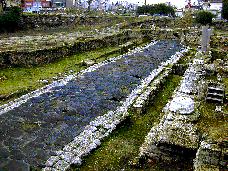
An Ancient Street in Tarsus
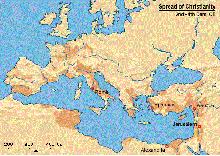
Spread of Christianity 2nd-4th Cent. CE
The Impact of the Revolts against Rome and the Destruction of the Temple
The Jewish revolt against the Romans in Judaea had complex causes. In fact,
the Roman imperial government officially tolerated Judaism, and exempted Jews
from participating in the cult of the emperor. But the Romans in Judaea routinely
offended Jewish sensitivities. They controlled the Temple and the Temple cult
in Jerusalem. They imposed harsh taxes and duties on the population, the revenue
from which they used to support Roman campaigns elsewhere. Moreover, the Roman
administration of the province was corrupt and many of its officials were hellenized
non-Jews who provoked the Jews in religious matters.
Attacks on the Romans broke out in the summer of 66 CE, fueled by the anger
of poor Jews who had become landless under heavy Roman taxation. In 67 CE, full-scale
war broke out. Jewish members of the elite who had to this point counseled caution
- wealthy landowners, members of the priesthood, and Sages - now took sides
with the rebels and helped to organize the Jewish forces militarily. Messianic
hopes encouraged Jews to pursue what was certainly a hopeless enterprise from
a military point of view.
Ultimately the rebellion failed. Roman legions under the general Vespasian marched
into Galilee with a large army. The Jewish rebels could hold out only in isolated
fortresses while the Romans consolidated their hold on the province in anticipation
of a march on Jerusalem. Early in 69 CE, Vespasian was declared Roman emperor;
in the spring of 70 CE, his eldest son Titus took charge of the campaign against
Jerusalem. Titus held the city under siege for five months, gradually breaking
down Jewish resistance. The Romans at last breached the walls and burned the
Temple to the ground; they completed the conquest by suppressing all Jewish
religio-political institutions, including the High Priesthood and the Sanhedrin.
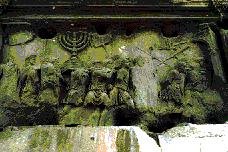
The Arch of Titus, detail, spoils from the Temple in Jerusalem
The crisis this defeat produced among the Jews was enormous. With the destruction
of the Temple, the loss of partial autonomy, and the massive loss of life, messianic
hopes were dashed and basic Jewish beliefs challenged. For more on the First
Revolt.
Two of the greatest scholars of the generation, Johanan ben Zakkai (mentioned
above) and Rabban Gamliel (son of Simon and grandson of Gamliel I, both mentioned
above), took the initiative in the task of Jewish national reconstruction. According
to legend, Johanan ben Zakkai was carried out of Jerusalem during the siege
concealed in a coffin. Foreseeing the disaster to come, he prepared to set up
a new Jewish center in Jabneh. He is attributed with teaching the replacement
of the three daily Temple sacrifices with three daily prayers - a substitution
that became a core element in a new Jewish way of life. Under a new generation
of scholars - heirs of the Pharisees - the synagogue became the focal point
of community life and Torah study the most highly regarded activity.
Still, hopes for regaining sovereignty and rebuilding the Temple had not been
entirely destroyed. Further disturbances against the Romans in 115-117 CE were
followed by provocative measures by the emperor Hadrian, who began an effort
to rebuild Jerusalem not as a Jewish city with a rebuilt Temple, but as a pagan
Greco-Roman city. The Jewish revolt that ensued was led by the messianic or
quasi-messianic figure Simon bar Kochba. It broke out in 132 CE and lasted three
and a half years before being suppressed, leaving most of the rebels dead. A
period of severe Roman persecution of the Jews began. Jerusalem was rebuilt
as a pagan city named Aelia Capitolina; Jews were forbidden to live in it. For
more on Bar Kochba revolt.
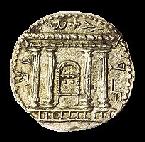
Coin of Bar Kochba, showing the Temple with the Ark of the Covenant
But there existed in Jewish tradition historical parallels that made the double
defeats of 70 CE and 135 CE bearable. The Temple and the city of Jerusalem had
been destroyed before. Jews had been forced into exile before, forced to live
under foreign domination. The biblical prophesies concerning the restoration
of Zion - the prophecies that had stirred the Bar Kochba revolt - came from
prophets who had witnessed Jewish defeat at the hands of the Babylonians long
ago. Moreover, the teachings of the scholars at Jabneh provided the foundations
for the continuation of Jewish life without a Temple in Jerusalem. A new generation
of scholars trained in the oral tradition undertook the task of renewal, this
time in towns in the Galilee. There, far from Jerusalem, these scholars produced
the important rabbinic material that was to become the Mishnah. As for Jews
living in the diaspora, there is no indication that conditions changed for them
in any dramatic way in the wake of events in Judaea.
The impact of these events on the development of Christianity was, however, profound. It is interesting that Christians did not see these events as theologically significant until after the Bar Kochba revolt. But at that point the destruction of Jerusalem came to play an important role in Christian teaching. The basic message is clear from the following passage by Origen (185 CE-c. 253), one of the Church Fathers (see below):
We say with confidence that they [the Jews] will never be restored to their former condition. For they committed a crime of the most unhallowed kind, in conspiring against the Savior of the human race in that city where they offered up to God a worship containing the symbols of mighty mysteries. It was thus fitting that the city where Jesus underwent these sufferings should perish utterly, and that the Jewish nation should be overthrown, and that the invitation to happiness offered them by God should pass to others. (Contra Celsus 4, 22)
By the time Origen was active, in the middle of the third century, good relations
had been restored between the Jews and the Roman imperial government. The Jewish
defeat that Christians stressed in their rhetoric - Jerusalem did, after all,
lay in ruins - was not reflected in Jewish-pagan relations, which continued
in time-honored patterns. By this time, it was actually the Christians whom
the Roman emperors were intent on persecuting. Let's look for a moment at this
twist in power relations.
Prior to the mid-third century, there had been only spontaneous, local attacks on Christians by pagans, who viewed the new sect as bizarre and lacking the ancestral foundations fundamental to cultic practice. Occasionally Roman emperors took hostile measures against the growing new sect. Nero, for example, took advantage of public hostility to Christians when he blamed them for the great fire of Rome in 64 CE. But persecution did not become systematic until the reign of Decius (249-251). During Decius's persecutions of Christians, Christians were forced to perform pagan sacrifices in public and, if they refused, they were imprisoned, tortured, and executed. These persecutions continued under Decius's successors, though not at the same level. It is worth noting, however, that it was in this period, when Christian fortunes were at a low point, that the Christian rhetoric about Jewish defeat developed.
The Christianization of the Empire
It is a common belief that when the Roman emperor Constantine "converted
to Christianity" in 312 CE, the empire suddenly "became Christian."
But of course the story is much more complex. How was it possible that the religion
of a marginal, persecuted minority in the second and third centuries became
the official religion of the entire Roman Empire by the end of the fourth century?
A first crucial step was Paul's definition of a new divine history, a new map
of the moral cosmos, one which embraced all of humankind. By mid-second century,
two separate communities existed, that of the Jews, on the one hand, and that
of the believers in Christ, on the other. But those who shared a belief in Christ
did not necessarily share very much else, theologically speaking. Working out
an orthodoxy - a set of doctrines that had institutional authority - was a long
process that had just begun.
Certainly Constantine's conversion was an important further step in the consolidation
of Christianity. Constantine, a successful general and son of a successful general,
found himself in 311 CE, during a period of great political chaos, faced with
war with the general Maxentius, who claimed to be sole emperor. Faced with Maxentius's
numerically superior army, Constantine went into battle reassured by a vision.
According to this vision he would conquer in the sign of Christ. Accordingly,
Constantine had his soldiers go into battle with Christ's monogram on their
shields (despite the fact that they were mostly pagans). The two armies met
at the Milvian Bridge over the Tiber River, and Constantine's troops won an
overwhelming victory. Constantine became, in some way, a believer in Christ.
The political struggle for sole imperial rule continued. Constantine achieved
that aim only in 325 CE. But his "conversion" (whatever it entailed,
which is not entirely clear) had immediate consequences. Shortly after his victory
at the Milvian Bridge, in early 313 CE, he issued the Edict of Milan, which
ensured the toleration of Christian worship throughout the Empire. This did
not bring about immediate radical change. The majority of the population remained
pagan, and in many ways Constantine himself remained half-pagan. He protected
pagan worship and even included it in some public functions. He was baptized
only shortly prior to his death in 337. Yet he remained strongly favorable toward
the God of the Christians. He must have been aware, aside from issues of conscience,
of the potential of this dynamic new religious movement to unite a sprawling
empire.
As far as the Jews were concerned, the tolerated status of Judaism had not changed.
But the status of Christianity had changed, quite fatefully. Christians were
released from prisons, and the churches, which the persecutions had caused to
lie empty, began to be filled. The emperor granted jurisdiction to the bishops'
courts. Other privileges were granted to the Church for its social welfare activities.
Constantine was also personally liberal in his largesse to the Church, contributing
magnificent objects for church ornamentation. The Church, for its part, made
certain concessions to the empire - tolerating the cult of the emperor, for
example, as it continued to be practiced in various forms.
In the wake of Constantine's "conversion," the Church continued to consolidate rapidly, both socially and institutionally. This process was halted only briefly and temporarily during the short (and fascinating) reign of Julian the Apostate (361-363), who sought to restore pagan supremacy.
Early Church Organization
The early church formed an ecclesia (from Greek for "assembly"),
a church with definite though at first rudimentary organization. Paul, addressing
the Corinthians (I.Cor. XII, 28), defined the hierarchy of authority: "First
apostles, second prophets, third teachers, next miracle workers, then healers,
helpers, and administrators." Sixty or seventy years later, Ignatius (d.
c. 110) spoke of Antioch and the Asian churches as possessing a monarchical
bishop, with presbyters and deacons. The transition, in two generations, from
apostles and prophets to bishops and presbyters is unfortunately shrouded in
obscurity. In any case, by the second century, church organization had already
taken on the hierarchical form that characterized its later development.
The highest official was the bishop, or leader of a local community of Christians.
The norm that was adopted was "one city, one bishop." The area of
the bishop's jurisdiction was the Roman administrative unit, civitas. The bishop's
authority was justified theoretically by the theory of apostolic succession,
first enunciated by Irenaeus of Lyons, c. 180. True interpretation of Scripture,
Irenaeus argued, could come only from the spiritual heirs of the apostles, that
is, the bishops. Thus authority was to be handed down by apostle to bishop to
next bishop.
It might appear that with such a scheme all bishops would be equal. But two
things tended toward the development of hierarchy among the bishops themselves.
First, some bishoprics had the distinction of having been founded by apostles
themselves. Second, bishoprics of important cities were wealthier and thus more
powerful. The bishops of the great cities of Antioch, Alexandria, Carthage,
Constantinople, and Rome emerged as the ones with greatest clout.
As early as the mid-third century, the bishops of Rome claimed primacy over
all other bishops on the grounds that the Roman Church owed its foundation to
two principle apostles, Peter and Paul, to whom monuments had been erected in
Rome in 160. In 381 this seemed to be ratified when a council of bishops, the
Council of Constantinople, recognized the bishop of Rome as having primacy over
the whole Church. Yet the structure was still fluid: In 451, notwithstanding
the earlier decision, the Council of Chalcedon recognized Constantinople as
equal to Rome and supreme over the churches of the eastern empire.
The real rise of the bishop of Rome to preeminence occurred during the fourth and fifth centuries. The term "pope" emerged as a title for the bishop of Rome only as a part of this process. Initially, the term "pope" (papa) meant simply "father," and was used to address any bishop. It was only in the sixth century that Rome asserted its exclusive claim to the term papa for its bishop. But that brings us to the eve of the medieval period, where we will pick up this discussion.
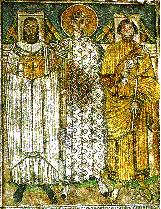
Mosaic showing St. Demetrius and bishops, Thessalonika
Church and Empire
By a natural process whose precise path could certainly not have been predicted, the Church adjusted to the realities of Greco-Roman culture and empire. In 382, the practice of paganism was prohibited by Roman law (though it lived on long after that date). To be Roman came to mean, more and more, being Christian; but to be Roman and Christian no longer meant to inhabit two worlds: they were becoming one. A wonderfully incisive description of this process has been made by the scholar Peter Brown in his World of Late Antiquity, pp. 82-4. Let me quote:
"If all men wanted to be Christians," the pagan Celsus wrote in 168, "the Christians would no longer want them." By 300 this situation had changed entirely. Christianity had put down firm roots in all the great cities of the Mediterranean: in Antioch and Alexandria the Church had become probably the biggest, certainly the best-organized single religious group in the town. The Christian gains had been made in just that part of the Roman world that had emerged comparatively unscathed from the troubles of the late third century. Silence descended on the stoutly pagan provinces of the West. By contrast, Syria and Asia Minor, with their vocal Christian elements, stood out more sharply than ever before as provinces of undimmed prosperity and intellectual ferment.
The most decisive change of that time, however, cannot be reduced to a matter of the size of the Christian communities. It was more significant for the immediate future of Christianity that the leaders of the Christian Church, especially in the Greek world, found that they could identify themselves with the culture, outlook and needs of the average well-to-do civilian. From being a sect ranged against or to one side of Roman civilization, Christianity became a church prepared to absorb a whole society. This…was certainly the most decisive single event in the culture of the third century. For the conversion of a Roman emperor to Christianity, of Constantine in 312, might not have happened - or, if it had, it would have taken on a totally different meaning - if it had not been preceded, for two generations, by the conversion of Christianity to the culture and ideals of the Roman world.
Origen of Alexandria (c. 185-c. 254) was the towering genius whose works summed up the possibility of such a venture in assimilation. His work, continued by a succession of Greek bishops, culminated in the writings of a contemporary and adviser of the emperor Constantine, Eusebius, bishop of Caesarea, from about 315 to about 340. For Origen and his disciples, Christianity was the "natural," the "original" religion. The "seeds" of Christian doctrine had been sown by Christ in every man. Ever since the Creation they had been variously tended by Him. Christ, therefore, had "tended" the best in Greek culture - especially Greek philosophy and ethics - as deliberately as He had revealed the Law to the Jews; the foundation of the universal Christian Church by Christ had been expressly synchronized with the foundation of a universal Roman peace by Augustus. A Christian, therefore, could reject neither Greek culture nor the Roman empire without seeming to turn his back on part of the divinely ordained progress of the human race. Christ was the "schoolmaster" of the human race, and Christianity was the peak of His education, the "true" paideia [Greek term for the ideal curriculum embracing all areas of learning], the "true" culture. Origen and his successors taught the pagan that to become a Christian was to step, at last, from a confused and undeveloped stage of moral and intellectual growth into the heart of civilization. On the sarcophagi and frescoes of the late third century, Christ appears as the Divine Schoolmaster, dressed in the simple robes of a professor of literature, lecturing - as Origen must have done - to a quiet circle of well-groomed disciples. The Christian bishop had become part of the intelligentsia of many a great Greek town: he, also, sat on a professor's "chair" - his cathedra; and he was thought of as "lecturing" his didaskaleion, his study-group, on simple and elevating ethical themes.
The Church Fathers and the Jews
Origen, mentioned in the passage above, was one of the so-called "Church
Fathers." These were the leading theologians who between the second and
sixth centuries defined basic Christian doctrine. The importance of their work
for the development of a coherent and sophisticated Christian theology cannot
be overstated. They elaborated thinking about such vital issues as the nature
of Jesus Christ and his relation to God the Father, the duties of the clergy,
infant baptism, celibacy and the priesthood, and so on.
One of the most important issues to be settled was the place of the Jews in
the Christian world (and in the divine drama as a whole). Virtually every major
Christian writer of the first five centuries either composed a treatise in opposition
to Judaism or made this issue a dominant theme in a treatise devoted to some
other subject. The literature of the Church Fathers on the Jews is referred
to as the Adversus Judaeos literature - literature "against the Jews."
We will be examining examples of this literature by two late fourth-century
Church Fathers, Chrysostom and Augustine.
In the period of the Church Fathers, the power relations between Jews and Christians
underwent dramatic change. This began, as we have noted, even before the Christianization
of the Roman Empire, with the two crises of 70 and 135 CE. For Christians, the
destruction of the Temple was a sign of divine anger, proof of Jewish blindness
and also the consequence of Jewish blindness. It also avenged the crime Jews
were felt to have perpetrated against Jesus. And by making impossible the observance
of much of the Law - that is, the laws of the Temple service, with its sacrifices
and rituals - it showed that the "old" covenant was no longer valid,
and that the "Old Israel" no longer had a role in history. The Church
Fathers not surprisingly dwelled on the theme of the rejection of the Jews and
the election of the Gentiles, as well as on the Jews' scattering and suffering
in exile.
They also laid the groundwork for some of the images of the Jew that were to
be most persistent (and most dangerous for the Jews under Christendom). In particular,
the notions that the Jews were, collectively, deicides, and moreover that they
habitually committed crimes of every sort (including idolatry) - these notions
entered Christian tradition through the Church Fathers. As we shall see in the
passage from Augustine, however, the Church Fathers also laid the groundwork
for the theoretical protection of Jewish life and limb in medieval Christendom.